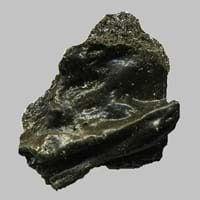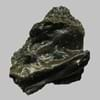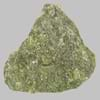Definition
Tachylite is a vitreous form of basaltic volcanic glass. This glass is formed naturally by the rapid cooling of molten basalt
Dacite is a volcanic igneous rock which is rintermediate in composition between andesite and rhyolite
Origin
Iceland
Romania and Moldova, Europe
Discoverer
Unknown
Unknown
Etymology
From German Tachylite, from tachy- + Greek lutos soluble, melting
From Dacia, a province of the Roman Empire which lay between the Danube River and Carpathian Mountains where the rock was first described
Class
Igneous Rocks
Igneous Rocks
Sub-Class
Durable Rock, Medium Hardness Rock
Durable Rock, Soft Rock
Other Categories
Coarse Grained Rock, Fine Grained Rock, Medium Grained Rock, Opaque Rock
Fine Grained Rock, Medium Grained Rock, Opaque Rock
Texture
Vitreous
Aphanitic to Porphyritic
Color
Black, Dark Brown
Bluish - Grey, Brown, Grey, Light to Dark Grey
Durability
Durable
Durable
Appearance
Glassy
Vesicular
Interior Uses
Decorative Aggregates, Interior Decoration
Decorative Aggregates, Entryways, Interior Decoration
Exterior Uses
As Building Stone, As Facing Stone, Garden Decoration, Paving Stone
As Building Stone, Paving Stone, Garden Decoration
Other Architectural Uses
Curbing
Curbing
Construction Industry
Cutting Tool, Knives, Landscaping, Scrapers
As Dimension Stone, Construction Aggregate, for Road Aggregate, Landscaping
Medical Industry
Not Yet Used
Not Yet Used
Antiquity Uses
Artifacts
Artifacts
Commercial Uses
Cemetery Markers, Creating Artwork
Commemorative Tablets, Creating Artwork
Types
Not Available
Footwall Dacite, Hanging wall Dacite, Tuff and Biotite Dacite
Features
Available in Lots of Colors and Patterns, Clasts are smooth to touch, NA
Host Rock for Lead, Is one of the oldest rock
Archaeological Significance
Monuments
Not Yet Used
Not Yet Used
Famous Monuments
Not Applicable
Not Applicable
Sculpture
Not Yet Used
Not Yet Used
Famous Sculptures
Not Applicable
Not Applicable
Figurines
Not Yet Used
Not Yet Used
Formation
Tachylite is a fine-grained, hard rock which is a type of metasomatite, essentially altered basalt. It forms with or without crystallization, either below the surface as intrusive rocks or on the surface as extrusive rocks.
Dacitic magma is formed by the subduction of young oceanic crust under a thick felsic continental plate. Further, the Oceanic crust is hydrothermally altered as quartz and sodium are added.
Mineral Content
Feldspar, Olivine
Amphibole, Apatite, Biotite, Feldspar, Garnet, Hornblade, Magnetite, Plagioclase, Pyroxene, Quartz, Zircon
Compound Content
Fe, Mg
Ca, Fe, Potassium Oxide, Mg, Potassium, Silicon Dioxide
Types of Metamorphism
Burial Metamorphism, Cataclastic Metamorphism, Contact Metamorphism, Hydrothermal Metamorphism, Impact Metamorphism, Regional Metamorphism
Burial Metamorphism, Cataclastic Metamorphism
Types of Weathering
Biological Weathering, Chemical Weathering, Mechanical Weathering
Biological Weathering, Chemical Weathering, Mechanical Weathering
Types of Erosion
Chemical Erosion, Sea Erosion, Water Erosion, Wind Erosion
Chemical Erosion
Grain Size
Medium to Fine Coarse Grained
Medium to Fine Coarse Grained
Fracture
Conchoidal
Conchoidal
Porosity
Less Porous
Less Porous
Luster
Resinous
Subvitreous to Dull
Compressive Strength
Not Available
Cleavage
Not Available
Perfect
Toughness
Not Available
Not Available
Specific Gravity
2.4
2.86-2.87
Transparency
Opaque
Translucent
Density
3.058 g/cm3
2.77-2.771 g/cm3
Resistance
Heat Resistant, Impact Resistant, Wear Resistant
Heat Resistant, Impact Resistant, Pressure Resistant, Wear Resistant
Deposits in Eastern Continents
Asia
Cambodia, Russia, South Korea
Not Yet Found
Africa
East Africa
Not Yet Found
Europe
England, Germany, Hungary, Iceland, Scotland, Sweden
France, Greece, Romania, Scotland, Spain
Others
Hawaii Islands
Not Yet Found
Deposits in Western Continents
South America
Not Yet Found
Argentina, Bolivia, Chile, Colombia, Ecuador, Peru, Venezuela
Deposits in Oceania Continent
Australia
Victoria
New Zealand, South Australia, Western Australia
Tachylite vs Dacite Characteristics
Though some rocks look identical, they have certain characteristics which distinguish them from others. Characteristics of rocks include texture, appearance, color, fracture, streak, hardness etc. Tachylite vs Dacite characteristics assist us to distinguish and recognize rocks. Also you can check about Properties of Tachylite and Properties of Dacite. Learn more about Tachylite vs Dacite in the next section. The interior uses of Tachylite include Decorative aggregates and Interior decoration whereas the interior uses of Dacite include Decorative aggregates, Entryways and Interior decoration. Due to some exceptional properties of Tachylite and Dacite, they have various applications in construction industry. The uses of Tachylite in construction industry include Cutting tool, Knives, Landscaping, Scrapers and that of Dacite include As dimension stone, Construction aggregate, For road aggregate, Landscaping.
More about Tachylite and Dacite
Here you can know more about Tachylite and Dacite. The life cycle of a rock consists of formation of rock, composition of rock and transformation of rock. The composition of Tachylite and Dacite consists of mineral content and compound content. The mineral content of Tachylite includes Feldspar, Olivine and mineral content of Dacite includes Amphibole, Apatite, Biotite, Feldspar, Garnet, Hornblade, Magnetite, Plagioclase, Pyroxene, Quartz, Zircon. You can also check out the list of all Igneous Rocks. When we have to compare Tachylite vs Dacite, the texture, color and appearance plays an important role in determining the type of rock. Tachylite is available in black, dark brown colors whereas, Dacite is available in bluish - grey, brown, grey, light to dark grey colors. Appearance of Tachylite is Glassy and that of Dacite is Vesicular. Properties of rock is another aspect for Tachylite vs Dacite. The hardness of Tachylite is 5.5 and that of Dacite is 2-2.25. The types of Tachylite are Not Available whereas types of Dacite are Footwall Dacite, Hanging wall Dacite, Tuff and Biotite Dacite. Streak of rock is the color of powder produced when it is dragged across an unweathered surface. The streak of Tachylite is vermilion while that of Dacite is white. The specific heat capacity of Tachylite is 0.56 kJ/Kg K and that of Dacite is 0.92 kJ/Kg K. Depending on the properties like hardness, toughness, specific heat capacity, porosity etc., rocks are resistant to heat, wear, impact, etc.Tachylite is heat resistant, impact resistant, wear resistant whereas Dacite is heat resistant, impact resistant, pressure resistant, wear resistant.





